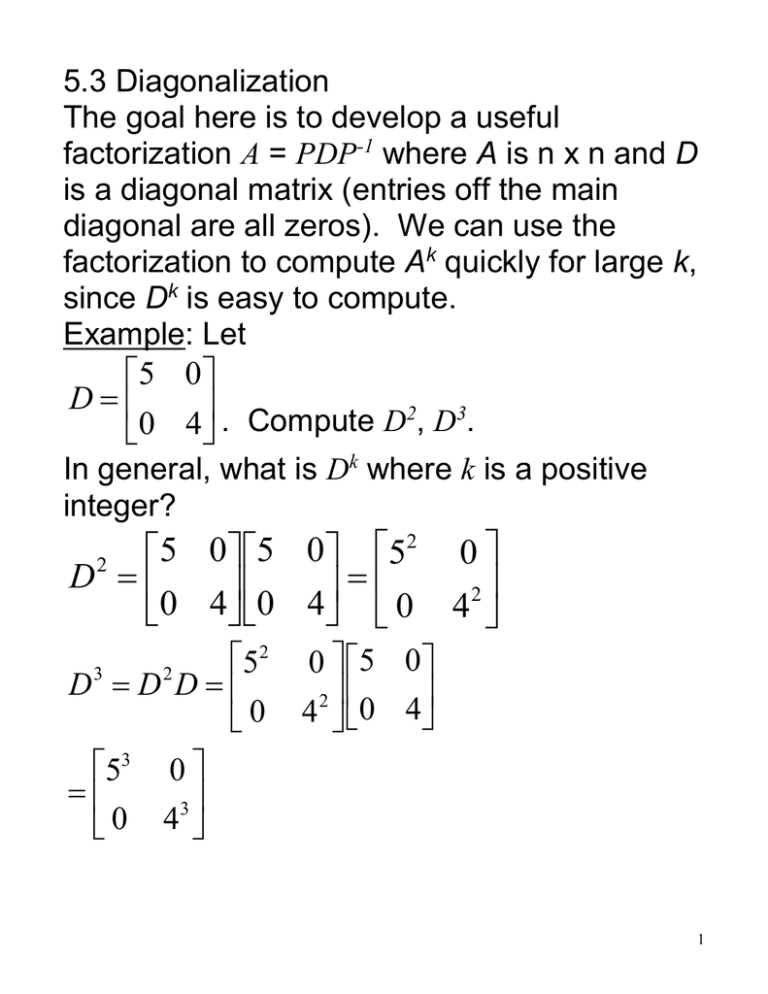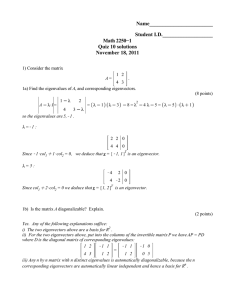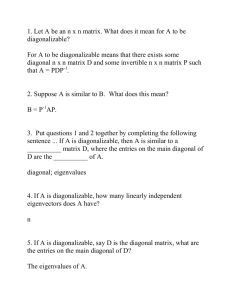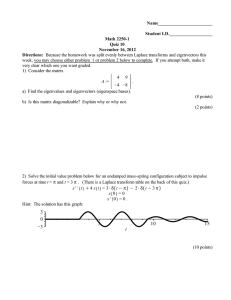Sec. 5.3 Diagonalization.doc
advertisement

5.3 Diagonalization The goal here is to develop a useful factorization A = PDP-1 where A is n x n and D is a diagonal matrix (entries off the main diagonal are all zeros). We can use the factorization to compute Ak quickly for large k, since Dk is easy to compute. Example: Let 5 0 D . Compute D2, D3. 0 4 In general, what is Dk where k is a positive integer? 2 5 0 5 0 5 2 D 0 4 0 4 0 2 5 D3 D 2 D 0 53 0 3 0 4 0 2 4 0 5 0 2 4 0 4 1 In general, k 5 0 k D k 0 4 Example: Let 6 1 A 2 3 Find a formula for Ak given: A = PDP-1 2 1 1 1 5 0 1 P P D , , 1 1 1 2 0 4 Start with symbols, and find a pattern. Since A = PDP-1, A2 PDP 1 PDP 1 PDDP 1 PD 2 P 1 A3 PD 2 P 1 PDP 1 PD 2 DP 1 PD3 P 1 2 So, Ak = PD k P-1. We can write this explicitly: 6 1 2 3 1 1 5k 1 2 0 k 0 2 1 k 4 1 1 5k 4 k 2 1 k k 1 1 5 2 4 2 5k 4 k 5k 4 k k k k k 2 5 2 4 5 2 4 This gives a nice compact formula which only takes two matrix multiplications. Definition: A square matrix is called diagonalizable if it is similar to a diagonal 1 matrix, that is A PDP where P is invertible and D is a diagonal matrix. 3 When is a matrix diagonalizable? Let’s look at the eigenvalues and eigenvectors of the previous example. Notice that: 6 1 1 5 1 2 3 1 5 51 , 1 So 1 is an eigenvector corresponding to the eigenvalue 5. Also, 6 1 1 4 1 2 3 2 8 4 2 , 1 so 2 is an eigenvector corresponding to λ = 4. These vectors are the columns of the matrix P, and the eigenvalues λ = 5, 4 are the entries on the diagonal of D. 4 Now we write: 6 1 1 1 5 4 AP 2 3 1 2 5 8 and, 5 4 1 1 5 0 5 8 1 2 0 4 PD . So, AP = PD 6 1 1 1 1 1 5 0 2 3 1 2 1 2 0 4 Multiplying by P-1 on the right on both sides of the equal sign gives: A = PD P-1 6 1 1 1 5 0 1 1 2 3 1 2 0 4 1 2 1 5 In general, 1 0 0 2 Av1 v 2 v n v1 v 2 v n 0 0 A v1 v 2 v n 0 v1 0 0 n And if v1 v 2 v n is invertible, 1 0 0 0 0 2 0 n v 2 vn 1 This brings us to … The Diagonalization Theorem: An n x n matrix A is diagonalizable iff A has n linearly independent eigenvectors. 1 A PDP In fact, with D a diagonal matrix iff the columns of P are the n linearly independent eigenvectors of A. In this case, the diagonal entries of D are the eigenvalues of A that correspond, respectively, to the eigenvectors in P. 6 Example: Diagonalize the following matrix if possible. 2 0 0 A 1 2 1 1 0 1 Step 1: Find the eigenvalues of A. Solve det A I 0 0 0 2 det 1 2 1 0 1 0 1 2 2 1 0 2 1 0 2 1,2 7 Step 2: Find three linearly independent eigenvectors of A, if possible. Solve A I x 0 for each value of λ. For λ = 1: 0 2 1 0 A 1I 1 2 1 1 1 0 1 1 1 0 0 1 1 1 1 0 0 The augmented matrix for 1 0 0 0 1 0 0 1 1 1 0 ~ 0 1 1 1 0 0 0 0 0 0 This gives the solution A I x 0 is : 0 0 0 0 0 0 x x3 x3 1 v1 1 x3 1 1 8 For λ = 2: 0 0 2 2 A 2I 1 2 2 1 1 0 1 2 0 0 0 1 0 1 1 0 1 The augmented matrix for A I x 0 is: 0 0 0 0 1 0 1 0 1 0 1 0 ~ 0 0 0 0 1 0 1 0 0 0 0 0 This gives the solution x3 0 1 x x2 x2 1 x3 0 x3 0 1 0 1 v 2 1, v 3 0 0 1 9 Step 3: Construct P from the vectors in step 2: 0 0 1 P 1 1 0 1 0 1 Step 4: Construct D from the corresponding eigenvalues. 1 0 0 D 0 2 0 0 0 2 Step 5: Use your calculator to check by verifying that AP = PD 0 0 2 AP 1 2 0 PD 1 0 2 So, A is diagonalizable with 10 1 0 1 1 0 0 0 0 1 D 0 2 0 P 1 1 0 P -1 1 1 1 , , 1 0 0 0 0 2 1 0 1 11 Example: Diagonalize the following matrix if possible. 2 4 6 A 0 2 2 0 0 4 Since A is triangular, the eigenvalues are 2 and 4. The basis for the eigenspace for λ = 2 is 1 v1 0 0 and the basis for the e-space for λ = 4 is 5 v 2 1 1 Every eigenvector of A is a multiple of v1 or v2, so A does not have three linearly independent eigenvectors, so by Th. 5.5, A is not diagonalizable. 12 Example: 2 0 0 A 2 6 0 Why is 3 2 1 diagonalizable? A has three distinct eigenvalues: λ = 2, 6, 1. Since eigenvectors corresponding the distinct eigenvalues are linearly independent, by Th. 5.2, 3 linearly independent eigenvectors, so A is diagonalizable by Th 5.5. This leads us to: Theorem 6: An n x n matrix with distinct eigenvalues is diagonalizable. Note: The converse is not true. It is not necessarily true that if a matrix is diagonalizable, it has n distinct eigenvalues. Example: Let 2 0 0 2 A 24 12 0 0 0 0 0 0 2 0 0 2 13 λ = –2, 2, each with multiplicity 2. Find the eigenvectors: Solving (A – λI)x = 0 Gives the basis for the space of λ = –2 1 0 0 1 v1 , v 2 6 3 0 0 and the basis for the space of λ = 2 0 0 0 0 v 3 , v 4 1 0 0 1 These are clearly linearly independent, so P v1 v 2 v 3 v 4 is invertible; thus A is 1 diagonalizable, and A PDP where 14 1 0 P 6 0 0 0 0 1 0 0 3 1 0 0 0 1 Note the order of the columns. and 2 0 0 2 D 0 0 0 0 0 0 0 0 2 0 0 2 and 1 0 0 1 -1 P 6 3 0 0 0 0 0 0 1 0 0 1 15






